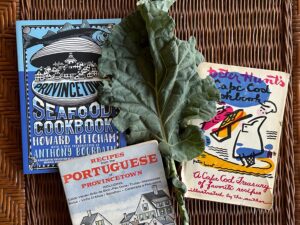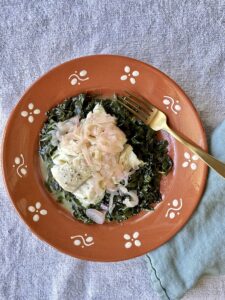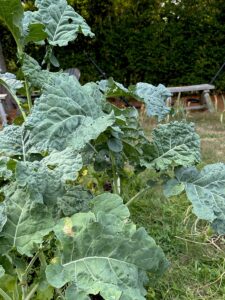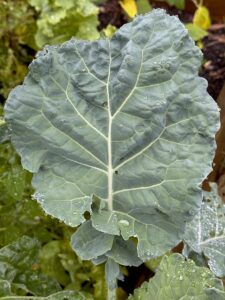I saw the dark green, somewhat spindly plantlets this past May at Bayberry Gardens in Truro. The hand-lettered sign contained a single word that I’d never seen before — “couves,” it said.
I asked Bayberry’s Brittany Souza what it meant. She had been told they were the authentic type of kale used in Portuguese dishes like caldo verde, but she said she didn’t know that much about them or even how to pronounce their name. “Coo-ves? Cooves?” she said with an unsure expression. “People come all the way from Provincetown to buy them.”
Being a gardener who gets a thrill trying a new plant variety, I bought a four-pack and planted them in my raised beds. They seemed kind of sickly and wan at first (maybe it was our dry, hot, and humid summer), but now, as August brings more temperate days and some real rain, they are thriving and have grown to be about waist high with large slightly ruffled leaves.

Intrigued by the mysterious name and wondering about the best way to prepare them, I turned to my small but growing library of Cape Cod cookbooks to see if I could find couves mentioned anywhere. I started with Howard Mitcham’s Provincetown Seafood Cookbook, published in 1975, which is filled with local historical tidbits. He names the classic caldo verde as sopa de couvres, with an “r.” But he used frozen or pre-chopped regular kale, so I moved on.
Next, I tried another out-of-print classic, Peter Hunt’s Cape Cod Cookbook, a charmingly illustrated 1954 title. In the first chapter, “The Portuguese Are Wonderful Cooks,” he begins with two recipes for kale soup. The first, called simply “couvres,” combines one pound of pea beans (I’m not sure what those are exactly), two pounds of kale, a half-pound of linguiça, and six small potatoes, all cooked for an hour in enough water to cover. “This is the simplest recipe for couvres,” he writes. “And the one prepared in most of the fishermen’s homes here.”
My next source finally gave me what I wanted. Mary H. Koehler’s 1973 cookbook Recipes From the Portuguese of Provincetown boasts 10 recipes for soups that feature kale (or cabbage, as sometimes they appear to be used interchangeably), including one called “couvres” (once again with the “r”).
Searching online, I got myself even more confused. There were sources for “couve” or “couvre” recipes and seeds from all over, even as far away as Hawaii, which, like the Cape, had a wave of Portuguese immigration in the 19th century. Some of the photos showed plants that looked more like collards. Some were curly. Some were silvery blue and slightly bumpy in texture like mine. Others were smooth with white ribs. It seems we have more than one kind of couves in the world.

Brittany suggested I ask Maria Silva at Café Maria near Macmillan Pier in Provincetown whether she knew anything about couves. Not only did she know it, she grows it.
“What kind do you grow?” she asked me. I showed her a photo from my garden, and she told me that mine was different from what she grows. “I like the one with flat, smooth leaves,” she said, pressing her hands together and sliding them gently against each other for emphasis. “The curly one is too tough for me.” She told me my variety looked a little like it was in the middle, texture-wise.
Maria uses couves in a lot of different ways (when I asked her if she ever saw it spelled with an “r” she made a face like I was crazy). She grows her couves in her garden from seeds imported from her native mainland Portugal where she said cooks prefer the smooth leaves.
“They like the curly one on the islands, I think,” she said. She cooks them in garlic as a side dish, with beans in a stew, and in caldo verde. She said she goes to the trouble to grow them because she finds them softer and sweeter than grocery store kale.

I found more evidence of the diversity of these kale varieties on the website of the European Cooperative Programme for Plant Genetic Resources. They list them all botanically as Brassica oleracea L. var. acephala, which they designate as a collard instead of a kale. Some sources also list it as a cabbage. Folklorically, the website lists them as couve-galega and notes that the names change according to where they are grown or used: couve de horto (from the vegetable garden), couve dos quintais (backyard cole), couve brava (wild cole), couve para caldo verde (for the soup), and couve de desfolhar (for “leaf plucking”). Not an “r” in sight, so it seems Maria is right.
Like many vegetables, they prefer sun, well-drained soil, and regular watering. Like any brassica crop, however, they are favorites of cabbage moth larvae, which can turn their beautiful two-foot leaves into lace unless you spray with BT (Bacillus thuringiensis). Over last year’s mild winter, I had a large regular kale plant that survived well into June, so I look forward to seeing if this new kale/collard/cabbage will also thrive. By the way, it’s pronounced COOO-ves with a big round “O” pronounced like the “coo” in “cool” and an almost imperceptible “ves.”

Once my inner plant nerd was satisfied, I turned my attention to cooking my couves and found them to be deliciously soft and sweet gently sautéed, then steamed. Following is an adaptation of a recipe that I saw Marian Morash make on PBS’s The Victory Garden television show decades ago, and I’ve been making it ever since. I share it because the simple direct flavors are a nice way to appreciate the flavor of the tender couves, but regular kale also works. It’s excellent with a side of potatoes of any sort.
CHEF MARIAN’S COD OVER KALE
Serves 2
4 cups chopped couves (or kale)
3 tablespoons olive oil
1 garlic clove, smashed
3 1-inch strips of lemon zest, finely chopped into slivers
1 pound of cod
4 tablespoons olive oil
2 tablespoons butter
1 large or 2 small shallots, chopped
1 lemon, juiced
Salt and pepper
- Cut the kale into a chiffonade by rolling 1 or 2 leaves tightly and slicing into quarter-inch ribbons.
- Heat 3 tablespoons of oil with the lemon zest and whole smashed garlic clove in a medium-to-large pot with a lid. Once the oil is warm but not too hot, add the kale and a pinch of salt and stir for about 3 minutes until it is wilted — you want to sauté the kale gently and not fry or brown it.
- Cut the cod into serving portions, season with salt and pepper, and place gently on the bed of kale. Cover the pot, turn the heat down to medium-low, and steam for 7 to 9 minutes (depending on the thickness of the fish: you want the cod to be opaque all the way through but still moist).
- While the cod is cooking, heat more olive oil and the butter in a small saucepan. Add the shallots and cook over medium heat until they are very soft. Do not brown. Add the lemon juice and a pinch of salt and turn the heat to low.
- Carefully lift the fish with some of the kale underneath onto plates, removing and discarding the smashed garlic clove (we want the focus to be on the shallot flavor). Place remaining kale around each piece. Spoon the shallot sauce over the fish and serve.
Plant sources: Bayberry Gardens in Truro gets seedlings only in spring. The Seedstead sells varieties under the name “couve tronchuda.” A white-ribbed variety, couve tronchuda a.k.a. tronchuda beira, is sold by Renee’s Garden and also at Johnny’s Selected Seeds, where it is referred to as Portuguese cabbage or sea kale.



